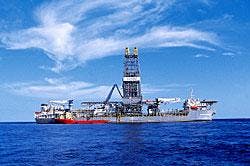Discoverer Enterprise ahead of the pack at Thunder Horse
Jennifer Pallanich Hull
Gulf of Mexico Editor
Transocean's Discoverer Enterprise moved further toward the duty it was designed for when it drilled two wells at once for BP.
The first ultra-deepwater drillship with dual-activity capabilities, the vessel recently latched a BOP on one Thunder Horse well in the Gulf of Mexico while landing and cementing the high-pressure wellhead on another well in BP's Mississippi Canyon Block 778 development in 6,033 ft of water.
"That was the plan from inception, to construct two wells at once, and this was our first opportunity," said Discoverer Enterprise Rig Manager Larry McMahan about the 1999 newbuild drillship.
The Discoverer Enterprise is the first of the trio of Enterprise-class vessels, and it has been a trendsetter in the industry while working with BP. It was the first to make inter-field moves with its BOP deployed. The Discoverer Enterprise, working in conjunction with the US Coast Guard and US Minerals Management Service, was the first deepwater drillship to use its crude oil storage and offloading abilities in August 2001 in an effort to show these activities could safely occur in the Gulf of Mexico. The vessel also held a subsea completion depth record in 6,407 ft of water that was recently broken by sister vessel Discoverer Spirit. The Discoverer Deep Seas is the third of the Enterprise-class vessels.
Bernard Looney, Thunder Horse drilling team leader for BP, said the non-conventional approach of drilling one well and working riserless on another well, cementing down to 20-in. is a $500,000 step toward a $2-$3-million savings per well if the entire well is worked riserless offline.
"This proved the concept that we can do this safely," Looney said. "I can physically attach the BOP to one well and can work riserless on another well."
The vessel was designed to drill one primary development well and multiple satellite wells around it and to conduct drilling steps simultaneously rather than sequentially as with traditional drillships.
"It's time-savings per well times how many wells you construct," McMahan said of the operator's potential cost savings for this activity. The batch setting can only be done in the field development environment.
Fully using the vessel requires a change from traditional, sequential thinking. Because the Discoverer Enterprise can work on two wells concurrently, it took a little while to move from the step-by-step schedule to "hey, we could actually get a head start" by drilling two wells at once, Looney said.
The Panama-flagged Discoverer Enterprise is under a five-year, $360 million contract in the Gulf of Mexico to BP through December 2004. The contract includes options for additional years.
Safety and a bonus
Before the vessel worked on the two development wells at once for BP, Transocean studied the risks associated with the ground- breaking maneuver. Because the Discoverer Enterprise is a DP-3 vessel, Transocean and BP considered the possibility of string collision as well as other risks. But the relatively short length of time involved - two and a half to four days - lessened the concern. One of the major threats to a vessel's dynamic positioning system is weather patterns, and threatening weather is now known well in advance, decreasing this risk, McMahan said.
Another factor was loop currents in the GoM. The 835-ft-long vessel cannot go broadside against the loop currents during dynamic positioning operations, he said.
"We know that there will be limitations to these activities," McMahan said.
One of the parameters of the operation was the distance between the wells. The deeper the water, the further apart the wells can be, he said. In 6,000 ft water depth, the wells could be as far apart as 150 ft. The determining factor is the angle exerted on the BOP stack. This angle, McMahan said, cannot reach 1° without risking damage to the BOP equipment or the wellhead.
There was an unexpected bonus with the strategy. While the vessel was working riserless cementing one well and drilling on the other well, Looney said, the team decided to spend more time than initially planned while waiting for the cement to set. The Enterprise was able to stay over the setting cement as a precautionary measure without concern for time or cost pressures, he said.
Looking forward
Two individual crews handle the two separate drilling assemblies on the single derrick dual rotary drillship. And those working with and on the rig are learning more about its capabilities with each well.
"The last prize for the Enterprise class rig is to J-lay pipeline," McMahan said.
Another step for the dual-activity rig is to drill consecutive wells deeper beyond 20-in. casing.
"Is it possible that in the future, we could drill two wells to deep depths?" Looney asked. "We don't know yet."
Both McMahan and Looney agree, though, that whatever the future moves of the Enterprise, it will depend on the drillship's team and the leadership of those at Transocean and BP.
In the meantime, BP plans to continue using the Enterprise's dual-drilling capability on Thunder Horse, Looney said.


